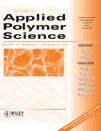Synthesis, characterization, and evaluation of copolymers based on N-isopropylacrylamide and 2-ethoxyethyl methacrylate for the controlled release of felodipine†
This article is Center of Excellence in Polymer Science Communication 192.
Abstract
The free-radical copolymerization of N-isopropylacrylamide (NIPAAm) with 2-ethoxyethyl methacrylate (EOEMA) was carried out with 2,2′-azobisisobutyronotrile as an initiator in 1,4-dioxane at 65°C. The resulting copolymer was characterized by Fourier transform infrared and 1H-NMR techniques. The composition of copolymers prepared at low conversion was determined by elemental analysis. An extended Kelen–Tudos method was used to estimate the reactivity ratios. The distribution of the monomer sequence along the copolymer chain was calculated with a statistical method based on the obtained reactivity ratios. Felodipine-loaded microspheres were prepared by the solvent evaporation technique. The effect of NIPAAm with respect to EOEMA segments on the sustained release of felodipine from the microspheres was investigated. Scanning electron micrographs of the microspheres indicated the formation of spherical microparticles in the size range 15–53 μm, even after they were loaded with the drug. The in vitro release studies of felodipine from the NIPAAm/EOEMA microspheres performed in a pH 7.4 medium showed that the rate of drug release was enhanced by an increase in the amount of NIPAAm; the size of the microspheres also increased with increasing NIPAAm in the copolymer. © 2008 Wiley Periodicals, Inc. J Appl Polym Sci, 2008




